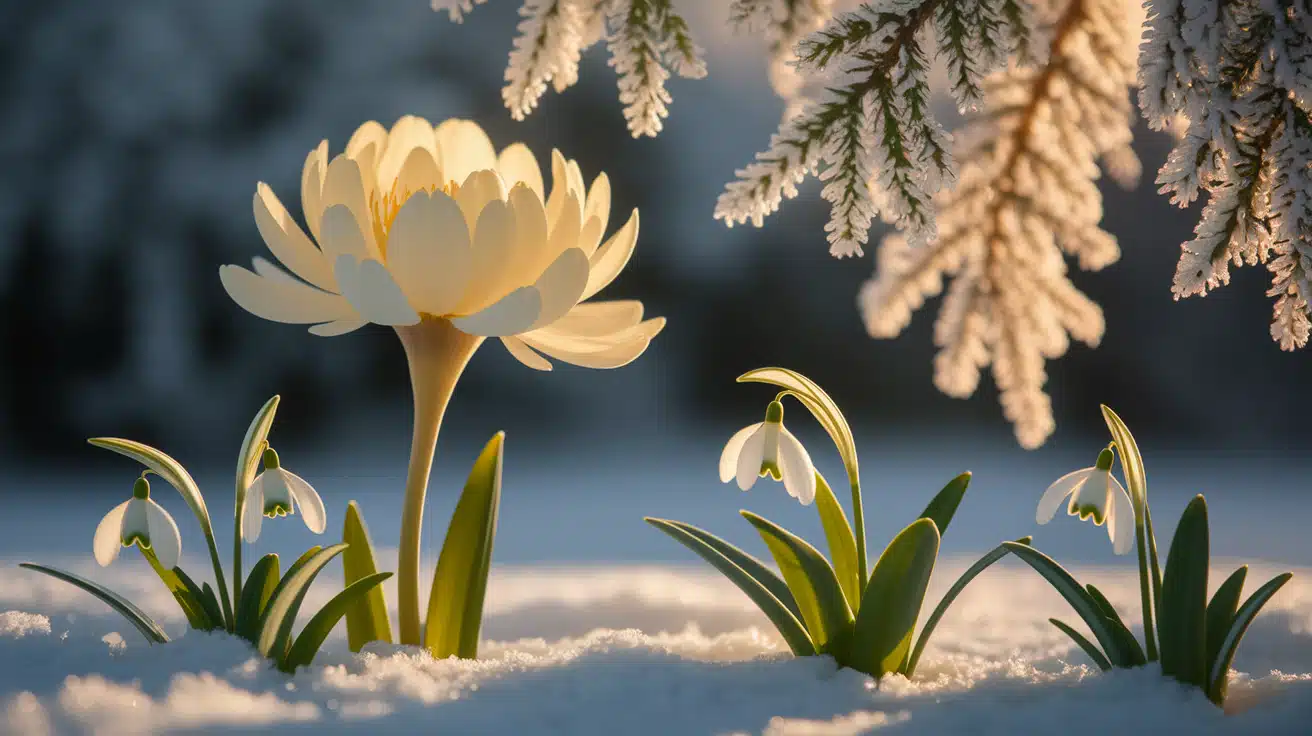Winter gardens don’t have to look lifeless and dull. Most gardeners watch their outdoor spaces turn brown and bare once cold weather arrives, leaving months of dreary landscapes until spring returns.
The solution is simple: plant winter flowers that bloom through the coldest season. These hardy plants bring vibrant colors, sweet fragrances, and visual interest to your garden when you need it most.
This guide showcases gorgeous winter flowers that thrive in cold weather conditions. You’ll learn exactly how to grow each variety, including their specific soil, sunlight, and pH requirements.
We’ll also show you why winter flowers benefit both the beauty of your garden and local wildlife. From bright yellow Winter Jasmine to fragrant Daphne, you’ll have everything needed to create a colorful winter garden that blooms all season long.
Why Choose Winter Flowers for Your Garden?
Winter flowers keep your garden colorful when most plants look dead or dormant. They offer unique benefits that make cold-season gardening a worthwhile endeavor.
Winter blooms add interest when other plants are dormant or have no flowers or leaves. Your garden stays attractive instead of looking empty and brown during the cold months. These hardy plants require less work than summer varieties, as they need minimal watering and face fewer pest problems in cold weather.
Key Benefits of Winter Flowers:
- Less maintenance – Reduced watering and pest control needs
- Long blooming time – Many flowers for months, not weeks
- Wildlife support – Provide food when other flowers are gone
- Mood booster – Bright colors help fight winter sadness
- Cost savings – Need less fertilizer and water
- Tough nature – Handle frost, snow, and cold winds easily
Winter flowers are naturally resilient and return each year with minimal care from you. Once planted, they provide consistent color and beauty throughout the cold season. Many varieties like pansies and hellebores bloom for several months, giving you more value than short-lived summer annuals.
Winter flowers provide color and beauty throughout the year, requiring less effort than traditional garden plants. They change your garden from a seasonal display into a reliable source of interest during the coldest months.
21 Winter Flowers That Bloom in the Cold Season
When winter arrives and most gardens look bare, these hardy flowers bring color and life to your outdoor space. You can choose from bright yellows, pure whites, and soft pinks to create a winter garden that blooms through the coldest months.
1. Winter Jasmine
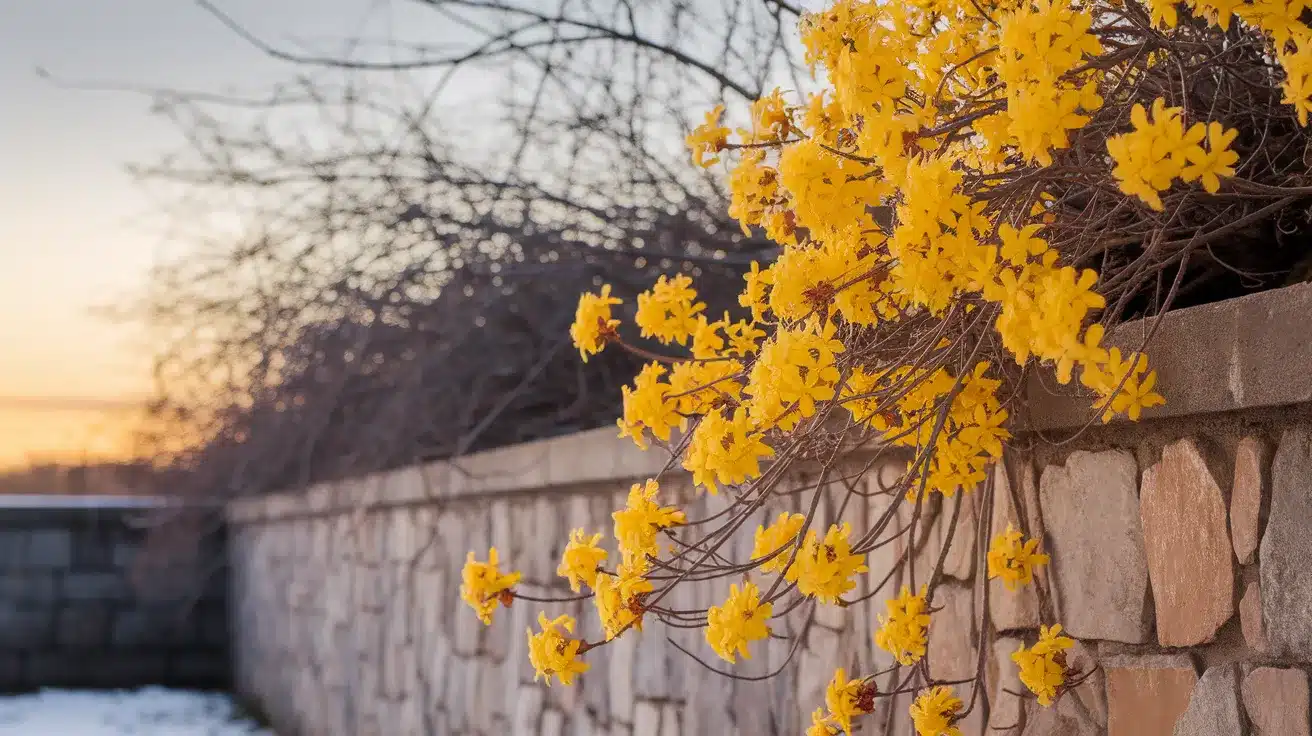
The bright yellow star that lights up winter gardens
You’ll love how Winter Jasmine produces cheerful yellow flowers from December through March. This hardy shrub thrives well on walls and slopes, making it ideal for addressing problem areas in your garden. The bright blooms appear before the leaves, creating a stunning display against bare branches.
Key Growing Details:
- Botanical Name: Jasminum nudiflorum
- Sun Exposure: Full sun to partial shade
- Soil Type: Well-draining, moist
- Soil pH: 6.0 – 7.5
2. Hellebore
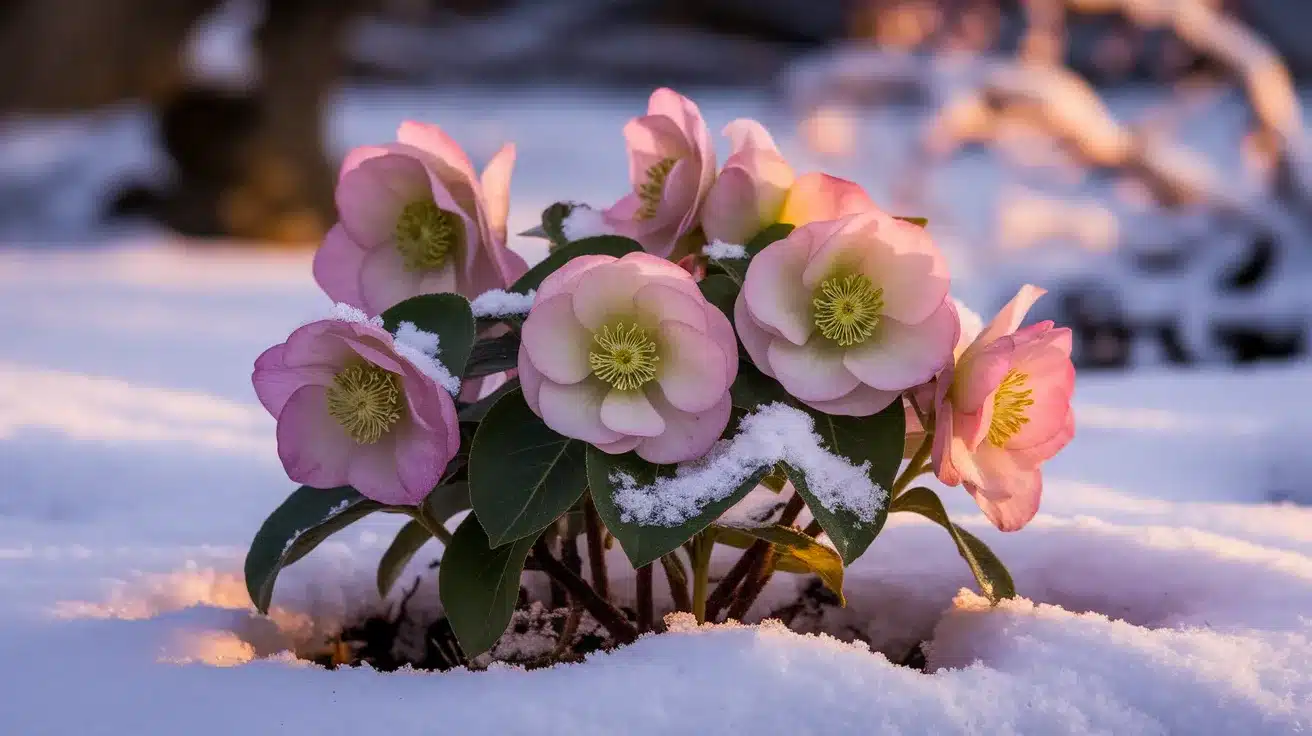
The Christmas Rose that blooms through snow
Hellebores are tough perennials that flower from late winter into spring. You can find them in colors ranging from white and pink to deep purple and green. These plants thrive in shady spots where other flowers struggle, making them ideal for woodland gardens.
Key Growing Details:
- Botanical Name: Helleborus spp.
- Sun Exposure: Partial shade
- Soil Type: Moist, well-drained
- Soil pH: 6.5 – 7.5
3. Snowdrop
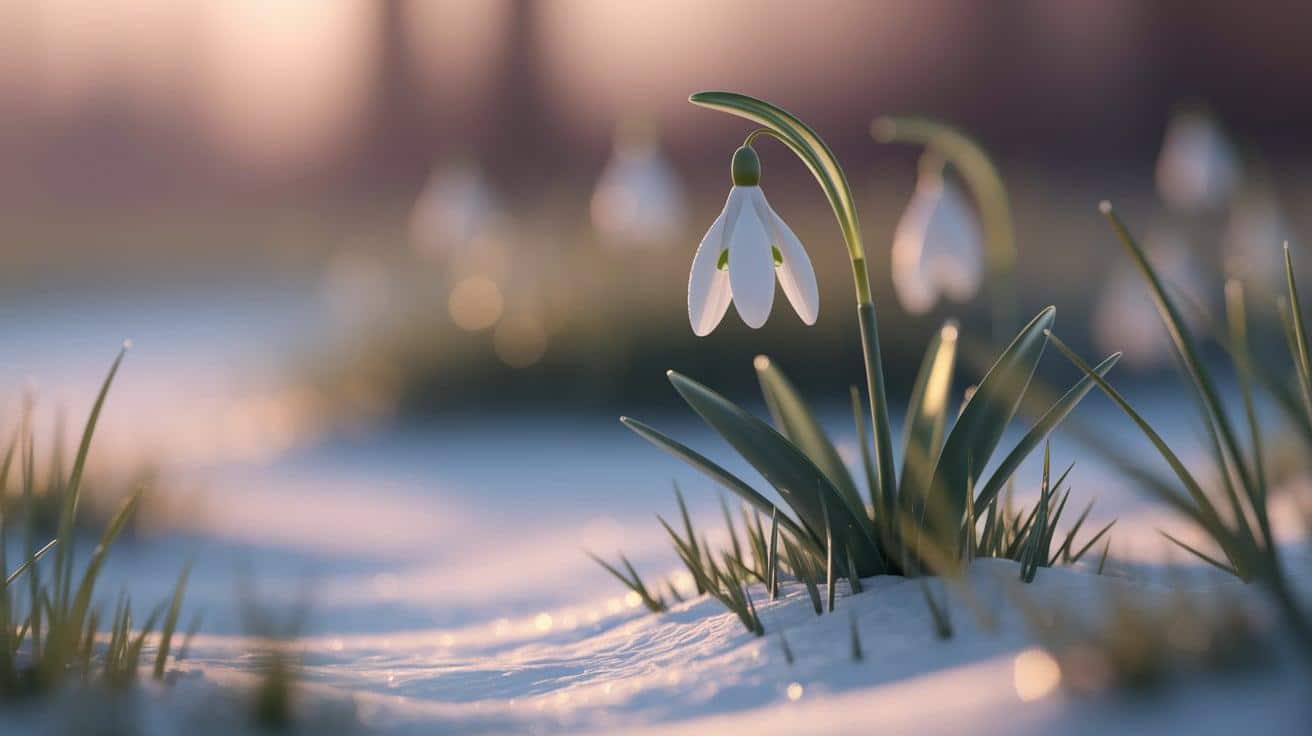
Tiny white bells that signal spring’s approach
Snowdrops are among the first bulbs to bloom each year. You’ll see their delicate white flowers pushing through snow in late winter. These small but mighty plants spread naturally over time, creating beautiful carpets of white blooms in your garden.
Key Growing Details:
- Botanical Name: Galanthus nivalis
- Sun Exposure: Partial shade to full sun
- Soil Type: Moist, well-draining
- Soil pH: 6.0 – 7.0
4. Witch Hazel
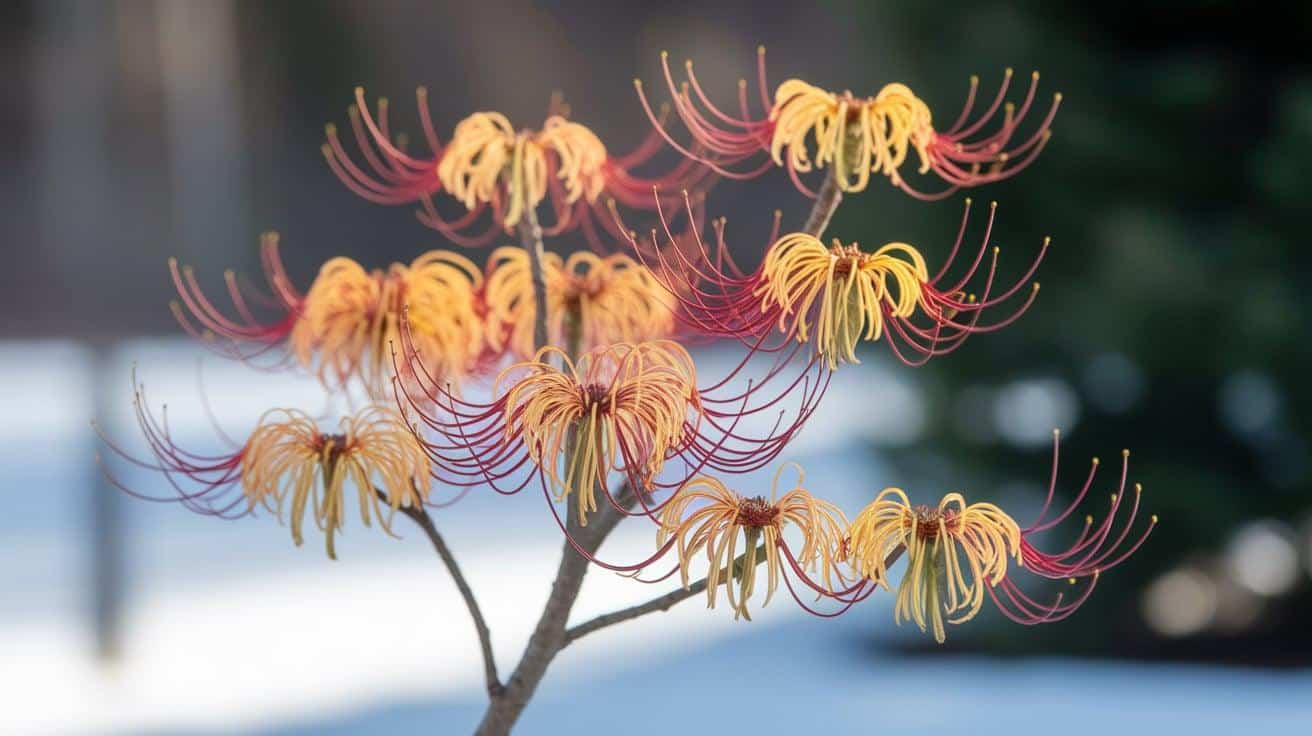
Fragrant spider-like blooms on bare branches
Witch Hazel offers you fragrant flowers in shades of yellow, orange, and red during the coldest months. The unusual spider-like petals create an interesting texture in winter gardens. You’ll appreciate how the sweet scent carries on cold air, attracting early pollinators.
Key Growing Details:
- Botanical Name: Hamamelis spp.
- Sun Exposure: Full sun to partial shade
- Soil Type: Moist, acidic to neutral
- Soil pH: 5.5 – 7.0
5. Camellia
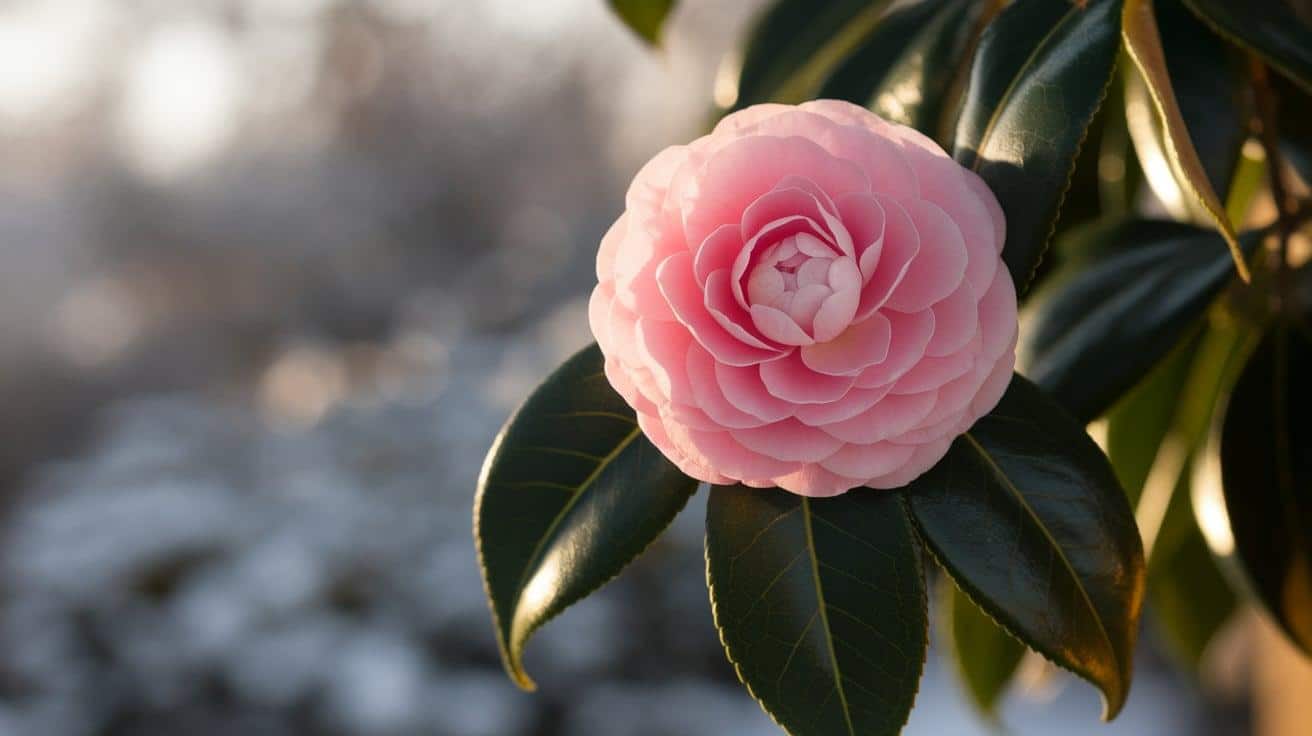
Large, rose-like blooms in winter and early spring
Camellias produce gorgeous flowers that look like perfect roses. You can choose from pink, red, white, or variegated varieties that bloom from winter through early spring. These evergreen shrubs also provide year-round structure with their glossy, dark green leaves.
Key Growing Details:
- Botanical Name: Camellia japonica
- Sun Exposure: Partial shade
- Soil Type: Acidic, well-drained
- Soil pH: 5.5 – 6.5
6. Winter Aconite
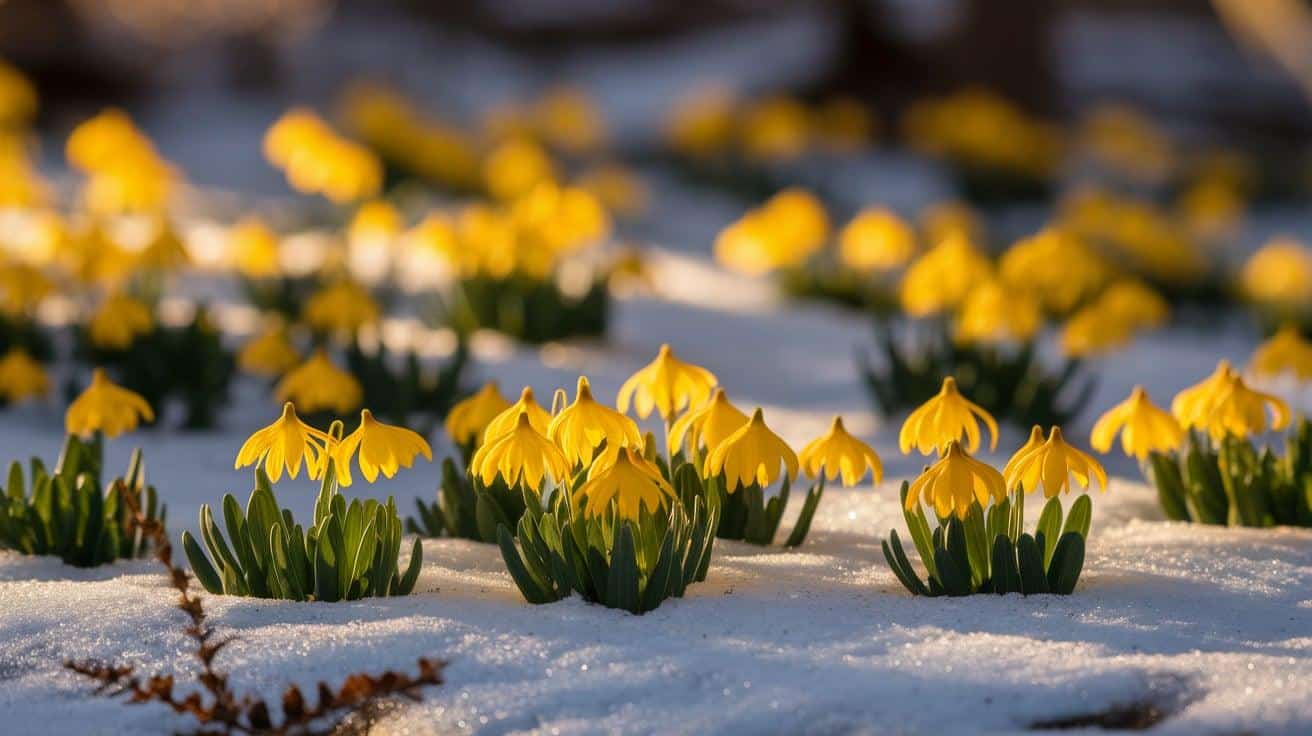
Golden cups that shine through winter gloom
Winter Aconite gives you bright yellow, buttercup-like flowers surrounded by green ruffs. These low-growing bulbs bloom very early in the season, often pushing through snow. You’ll find they naturalize well, creating golden carpets in woodland settings.
Key Growing Details:
- Botanical Name: Eranthis hyemalis
- Sun Exposure: Partial shade to full sun
- Soil Type: Moist, humus-rich
- Soil pH: 6.0 – 7.0
7. Daphne
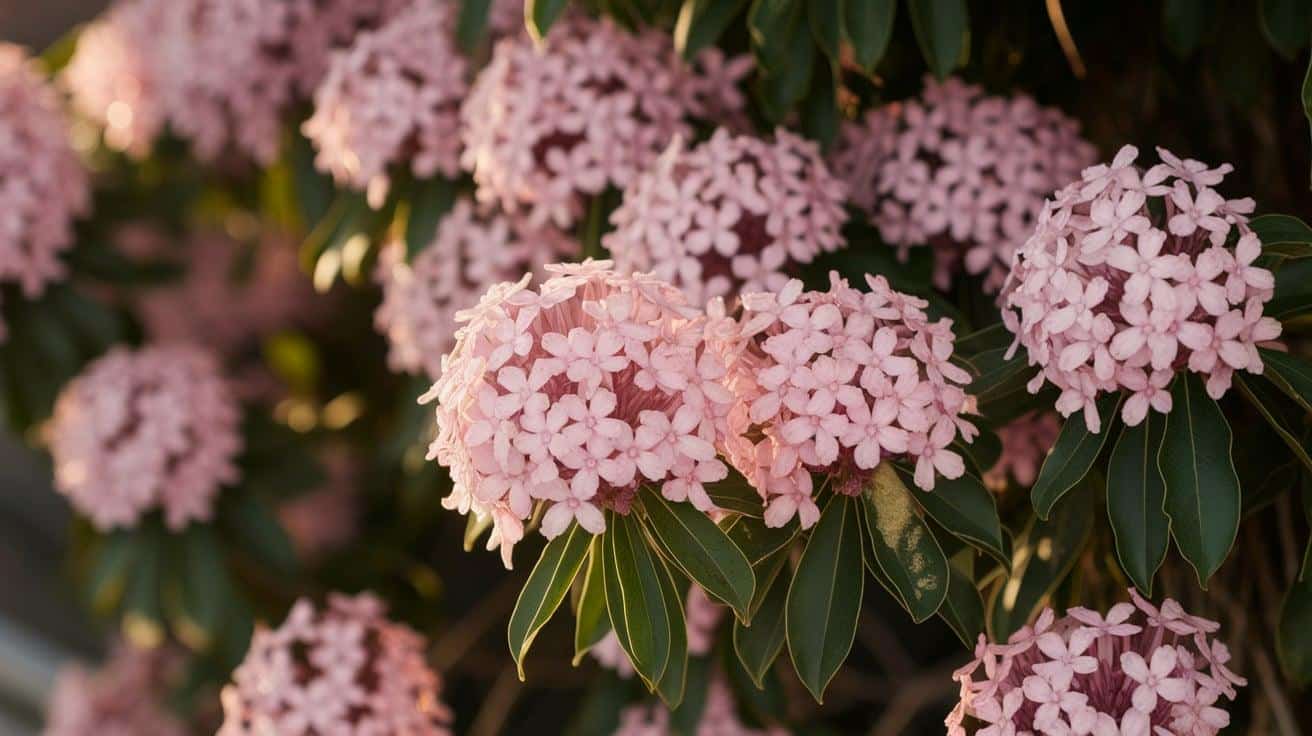
Intensely fragrant pink flowers that perfume the winter air
Daphne produces clusters of small, intensely fragrant pink or white flowers. You’ll notice the sweet perfume from quite a distance, making it perfect near pathways or seating areas. This evergreen shrub blooms from late winter into early spring.
Key Growing Details:
- Botanical Name: Daphne odora
- Sun Exposure: Partial shade
- Soil Type: Well-draining, rich
- Soil pH: 6.0 – 7.0
8. Pansy
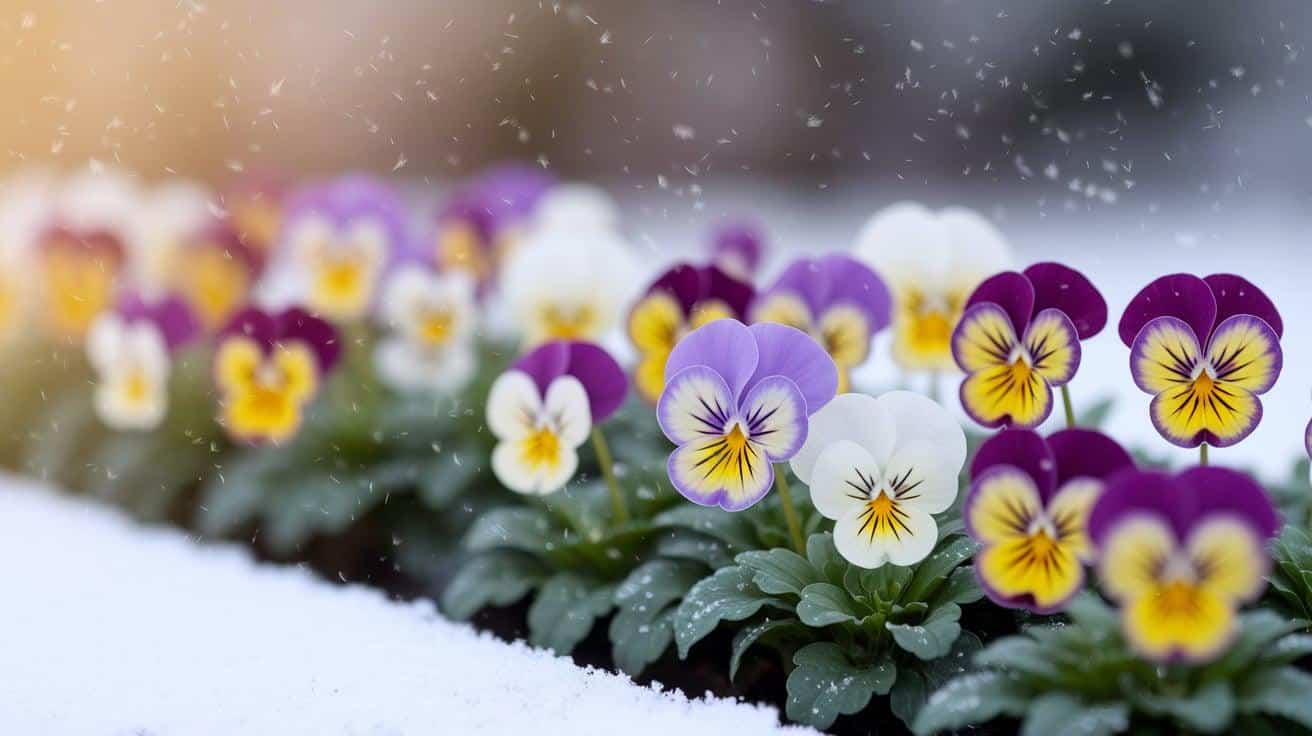
Cheerful faces that smile through frost
Pansies provide colorful faces in purple, yellow, white, and orange throughout winter in mild climates. You can use them in containers, borders, or as ground cover. These hardy annuals continue blooming even through light frosts.
Key Growing Details:
- Botanical Name: Viola tricolor var. hortensis
- Sun Exposure: Full sun to partial shade
- Soil Type: Well-drained, moist
- Soil pH: 6.0 – 7.5
9. Cyclamen
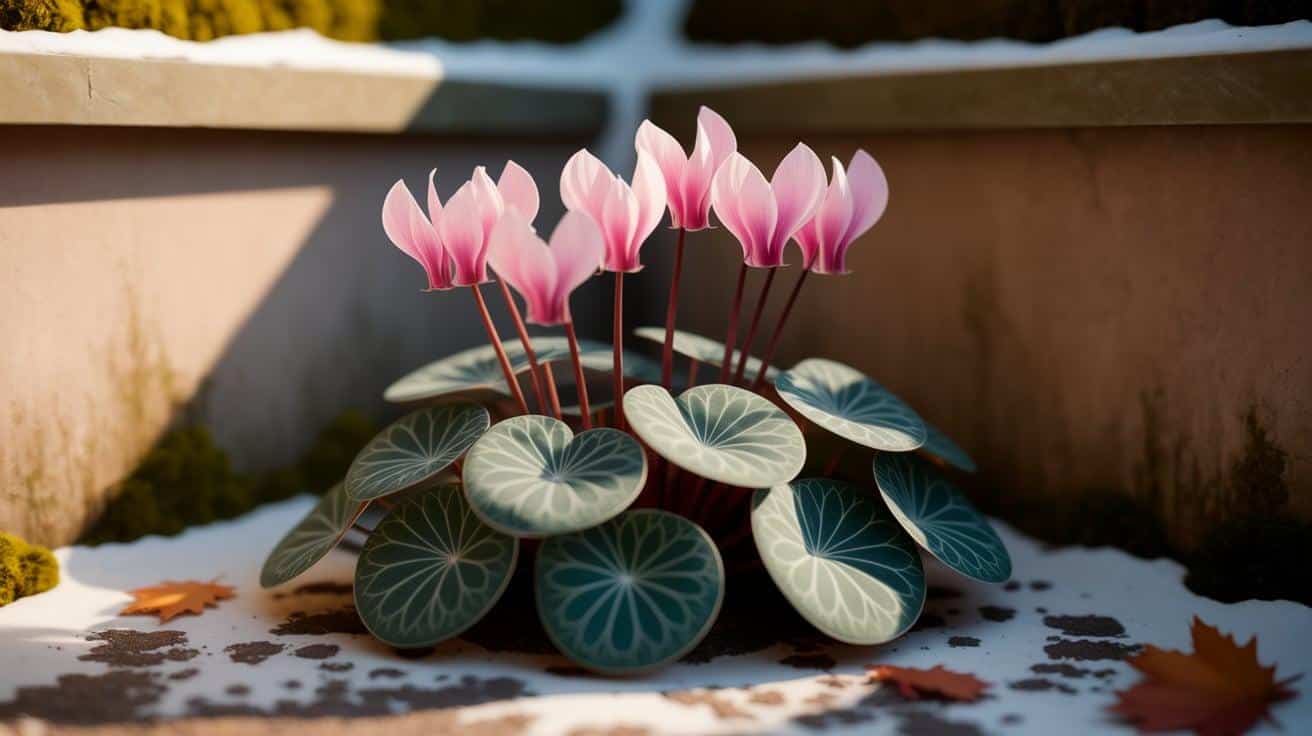
Delicate pink flowers above heart-shaped leaves
Hardy Cyclamen produces flowers with swept-back petals in pink, white, or magenta, above marbled leaves. You’ll appreciate how these small bulbs bloom from late winter into early spring. They’re perfect for naturalizing under trees or in rock gardens.
Key Growing Details:
- Botanical Name: Cyclamen coum
- Sun Exposure: Partial shade
- Soil Type: Well-draining, humus-rich
- Soil pH: 6.0 – 7.0
10. Mahonia
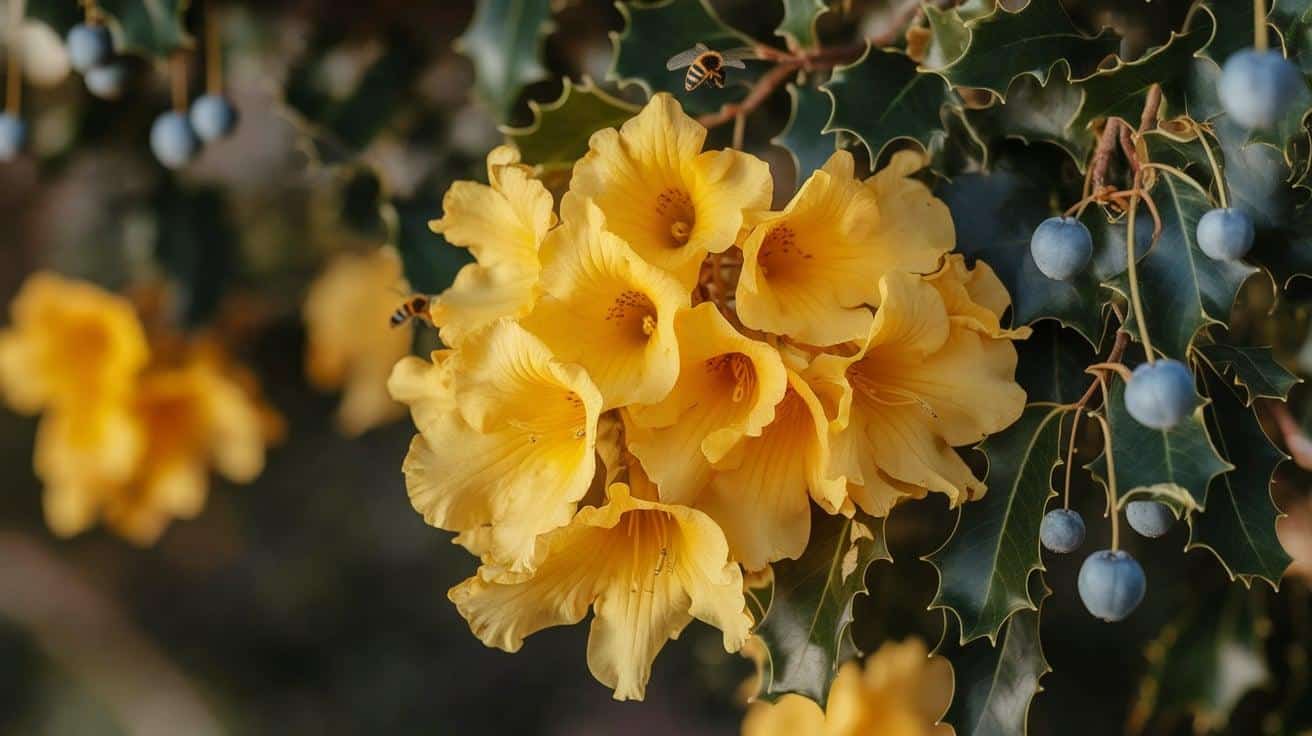
Yellow flower clusters with holly-like leaves
Mahonia offers you bright yellow flower clusters that bloom from late winter into spring. The spiky, holly-like leaves provide year-round interest, while the flowers attract early bees. You’ll also enjoy the blueberries that follow the blooms.
Key Growing Details:
- Botanical Name: Mahonia spp.
- Sun Exposure: Partial shade
- Soil Type: Moist, well-draining
- Soil pH: 5.5 – 7.0
11. Snowflake
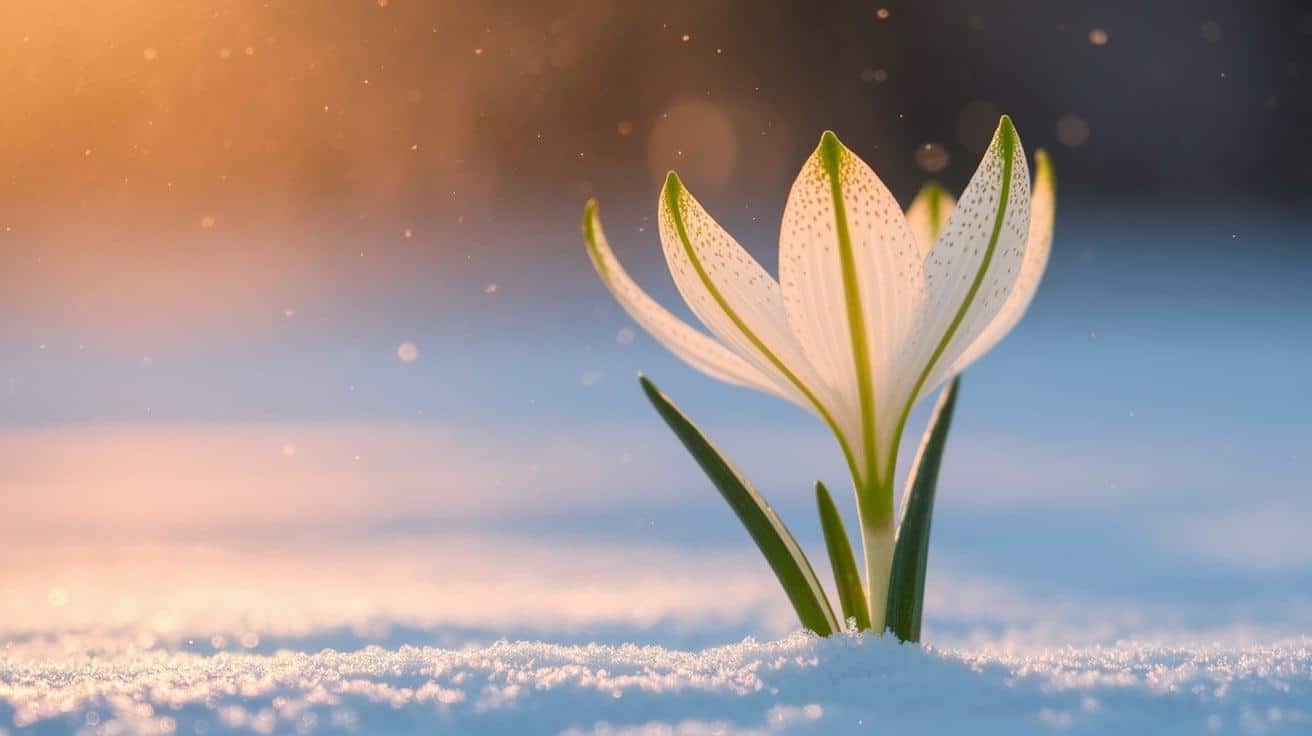
Larger cousin of snowdrops with green-tipped petals
Snowflakes resemble snowdrops but are larger and taller. You’ll notice the distinctive green spots on each white petal tip. These bulbs bloom slightly later than snowdrops, extending your early spring display.
Key Growing Details:
- Botanical Name: Leucojum vernum
- Sun Exposure: Partial shade to full sun
- Soil Type: Moist, well-draining
- Soil pH: 6.0 – 7.0
12. Calendula
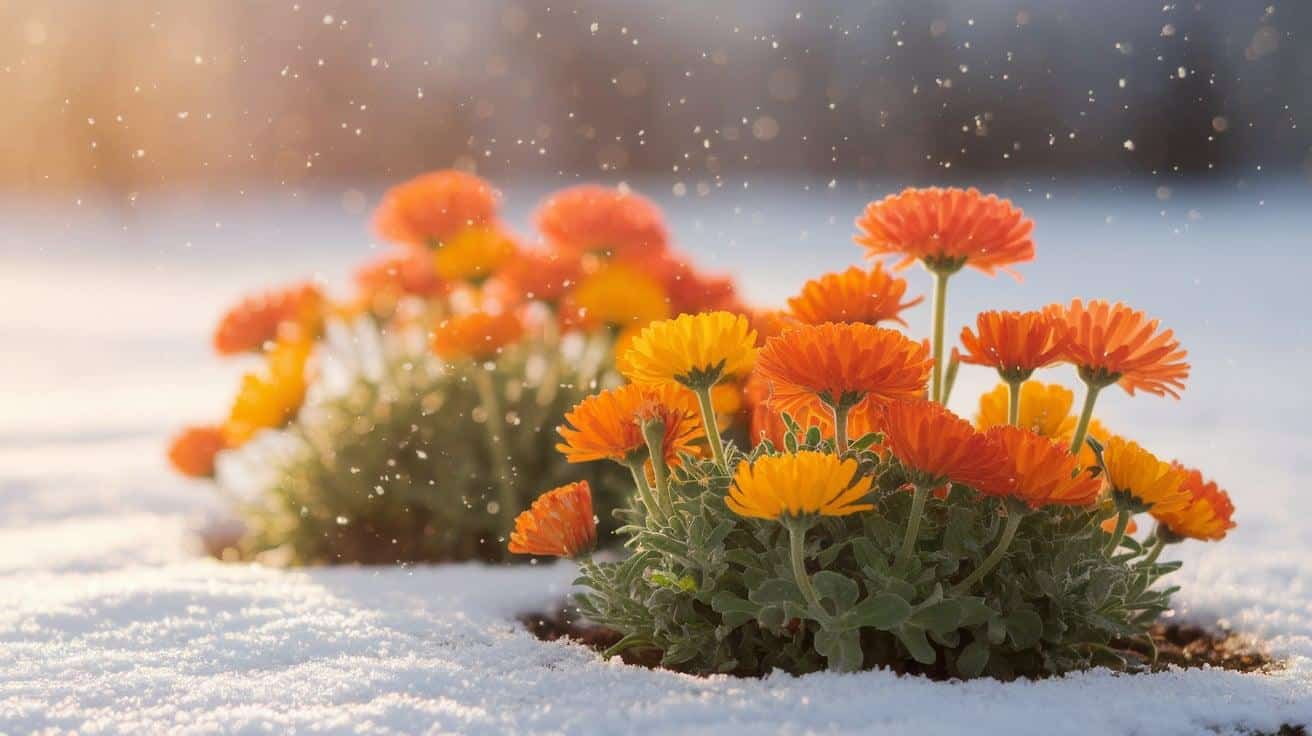
Bright orange and yellow daisies for winter color
Calendulas provide cheerful, orange, and yellow daisy-like flowers throughout winter in mild areas. You can use the edible petals in salads or as an ingredient in teas. These easy-to-grow annuals self-seed readily, ensuring a continuous supply of flowers for years to come.
Key Growing Details:
- Botanical Name: Calendula officinalis
- Sun Exposure: Full sun
- Soil Type: Well-draining
- Soil pH: 6.0 – 7.0
13. Heather
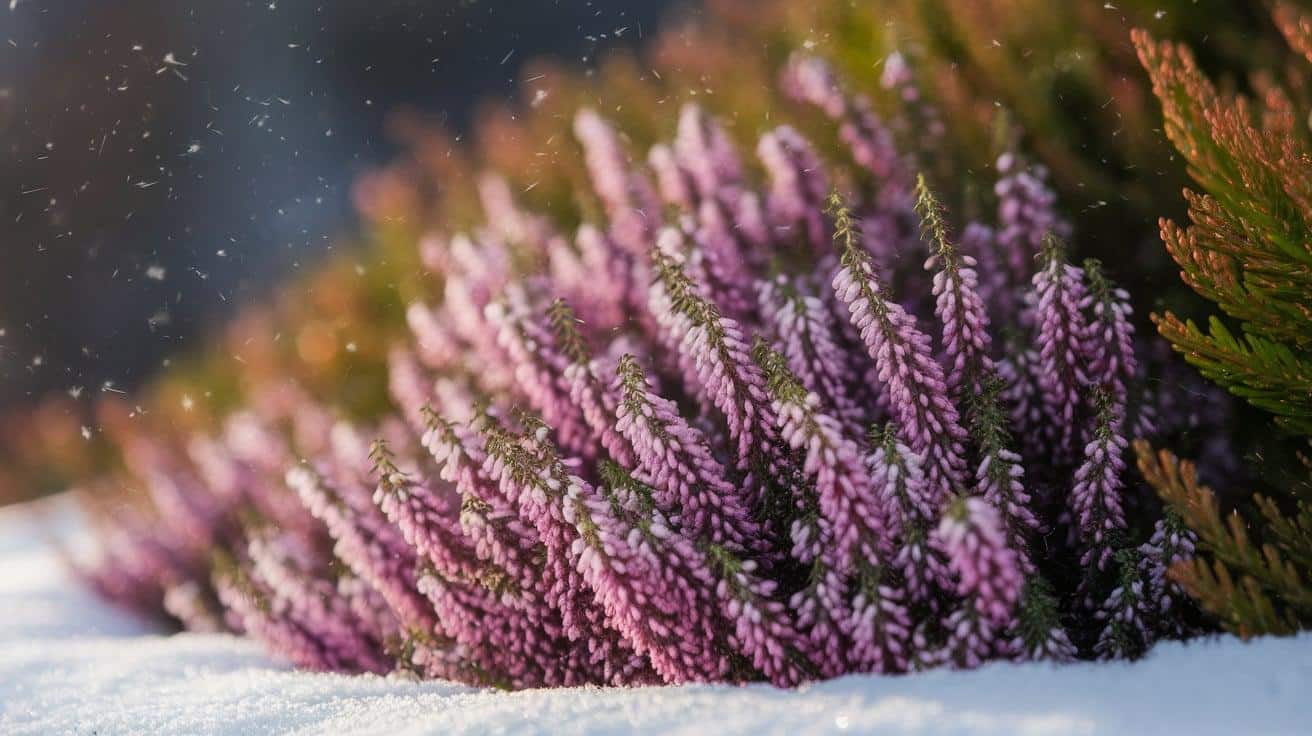
Tiny bell-shaped flowers in pink, purple, and white
Heather gives you masses of tiny flowers in shades of pink, purple, or white from late summer through winter. You’ll love how the evergreen foliage provides year-round color, changing from green to bronze or red in winter.
Key Growing Details:
- Botanical Name: Calluna vulgaris
- Sun Exposure: Full sun
- Soil Type: Acidic, well-draining
- Soil pH: 4.5 – 5.5
14. Iris Reticulata
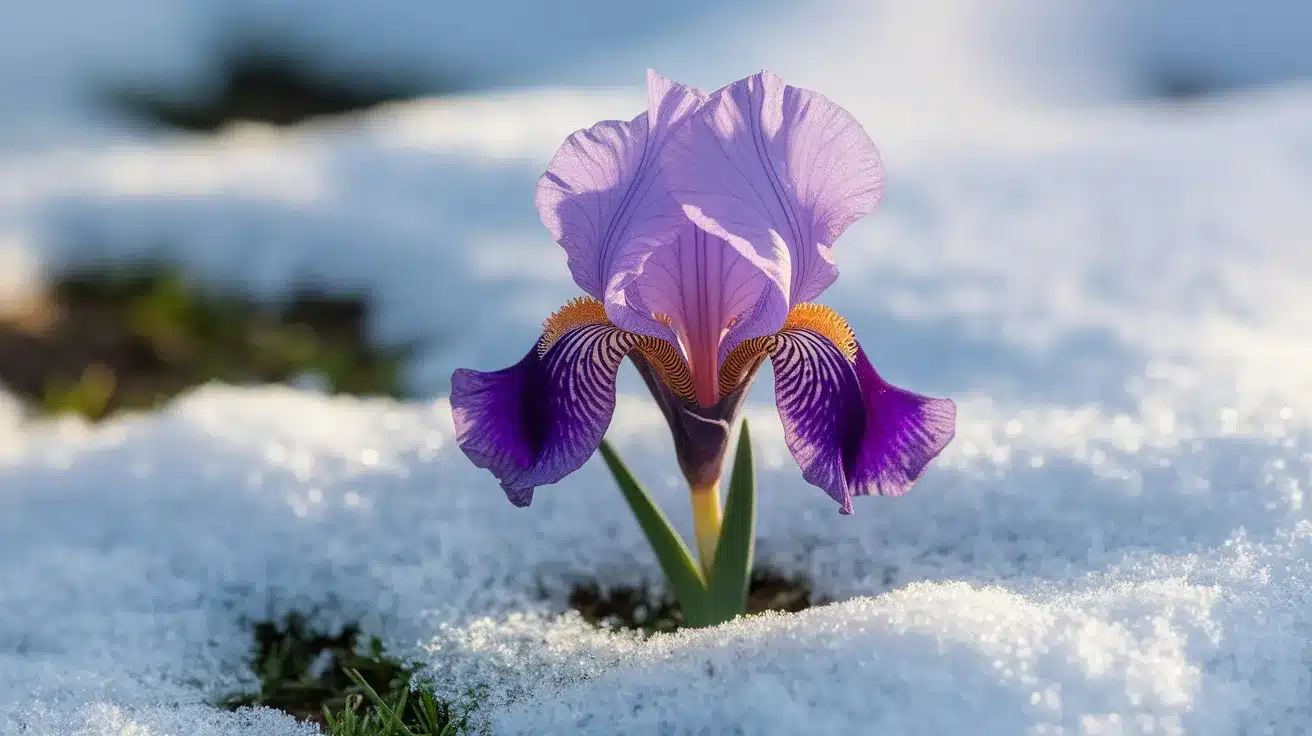
Miniature irises that brave the cold
These dwarf irises produce perfect miniature flowers in blue, purple, or yellow with intricate markings. You’ll be amazed how these small bulbs push through snow to bloom in late winter. They’re ideal for rock gardens or naturalizing.
Key Growing Details:
- Botanical Name: Iris reticulata
- Sun Exposure: Full sun
- Soil Type: Well-drained, sandy
- Soil pH: 6.5 – 7.5
15. Winter-Flowering Viburnum
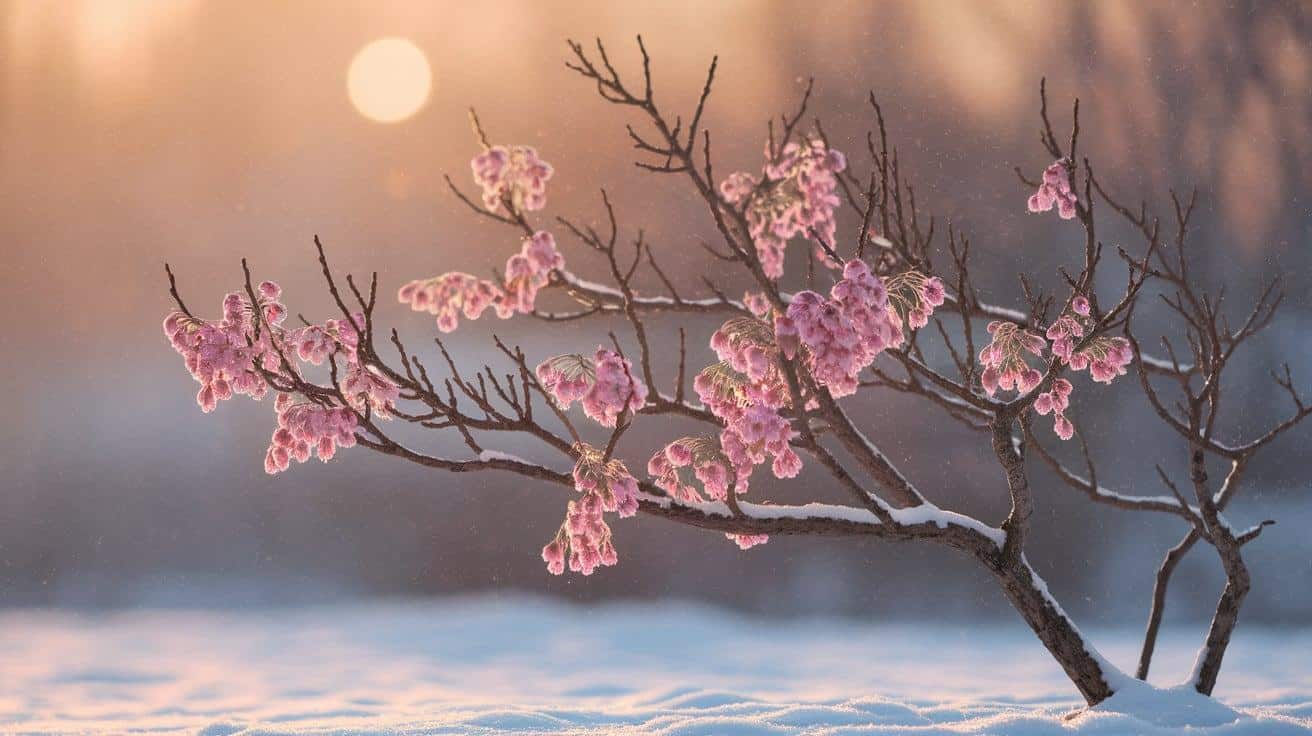
Fragrant pink clusters on bare winter branches
This Viburnum produces clusters of fragrant pink flowers on bare branches from November through March. You’ll appreciate the sweet scent that carries well in cold air. The deciduous shrub also offers good autumn color before losing its leaves.
Key Growing Details:
- Botanical Name: Viburnum x bodnantense
- Sun Exposure: Full sun to partial shade
- Soil Type: Moist, well-draining
- Soil pH: 6.0 – 7.0
16. Mahonia Media
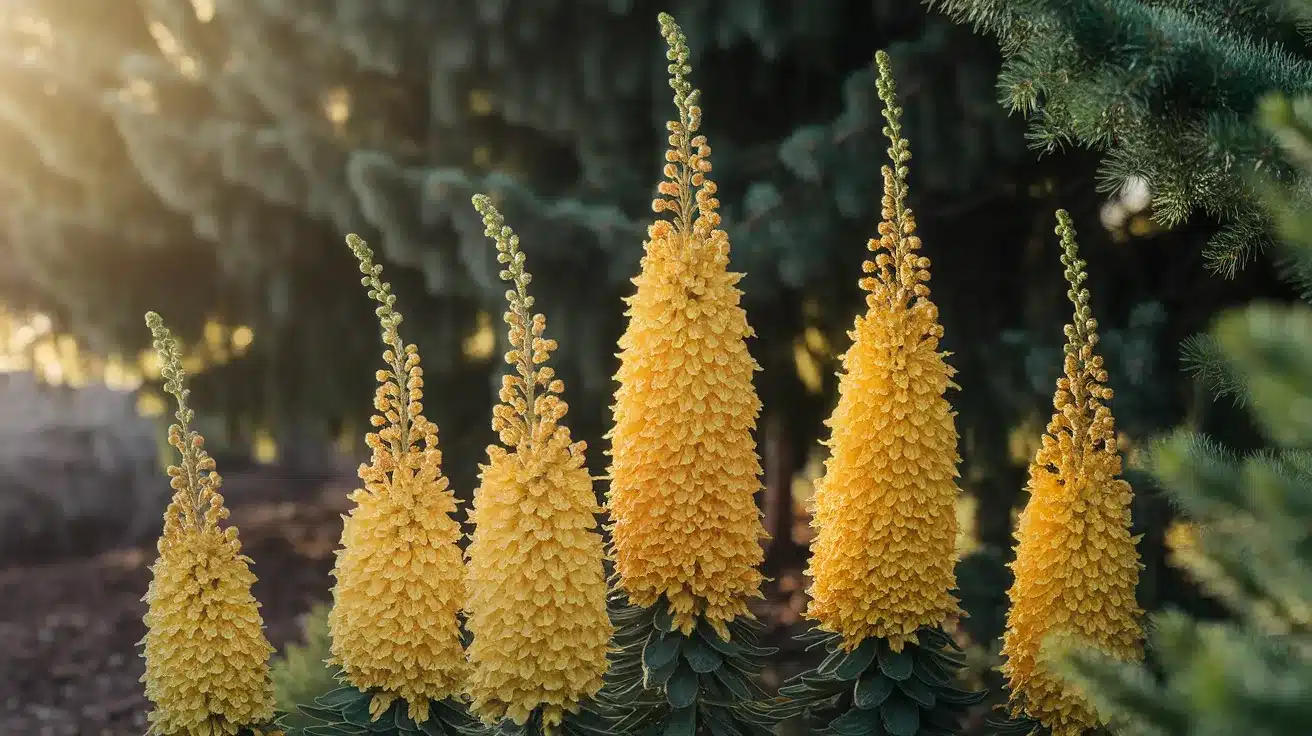
Tall spikes of fragrant yellow flowers
This hybrid Mahonia produces tall spikes of bright yellow, fragrant flowers from winter to spring. You’ll find it grows larger than other Mahonia species, making it perfect as a specimen plant or informal hedge.
Key Growing Details:
- Botanical Name: Mahonia x media
- Sun Exposure: Partial shade
- Soil Type: Moist, well-draining
- Soil pH: 5.5 – 7.0
17. Mahonia Aquifolium
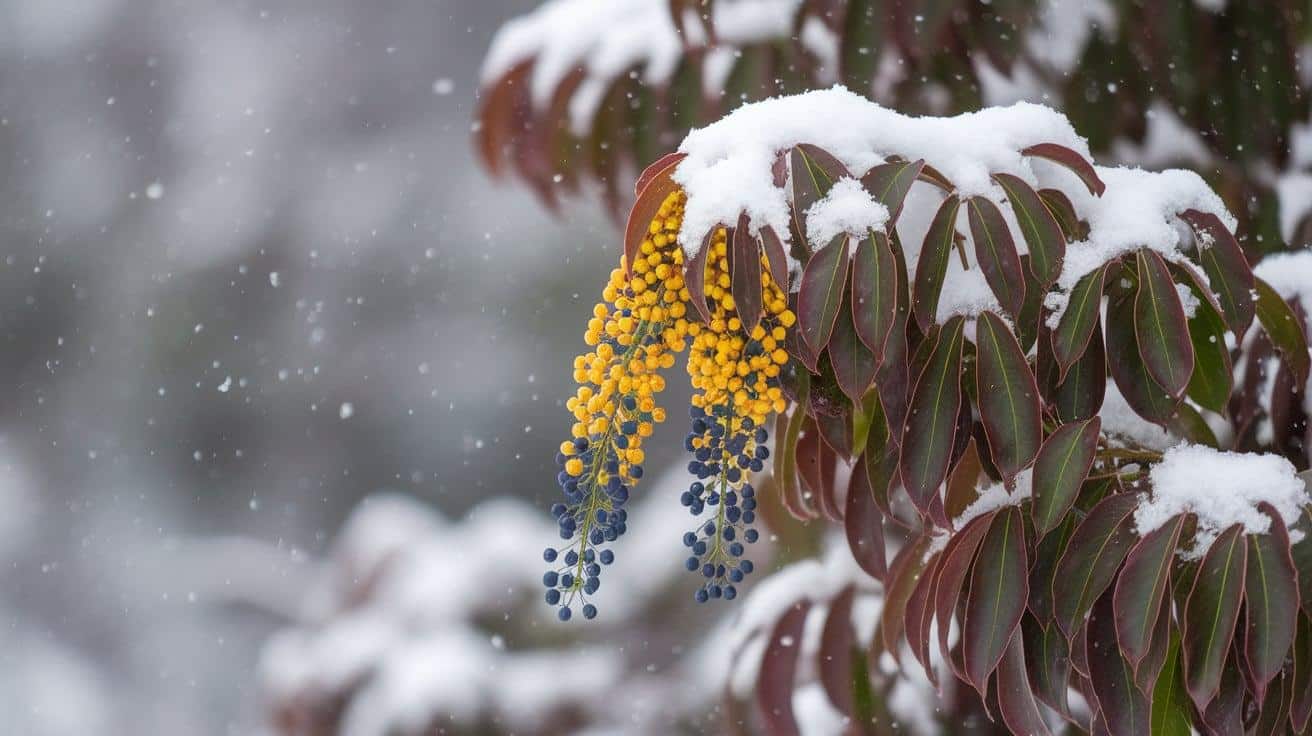
Oregon Grape with yellow flowers and blue berries
Oregon Grape produces bright yellow flower clusters followed by blue berries that birds love. You’ll appreciate how the glossy leaves turn bronze-purple in winter. This native plant is excellent for wildlife gardens and naturalizing.
Key Growing Details:
- Botanical Name: Mahonia aquifolium
- Sun Exposure: Partial shade
- Soil Type: Moist, well-draining
- Soil pH: 5.5 – 7.0
18. Delphinium
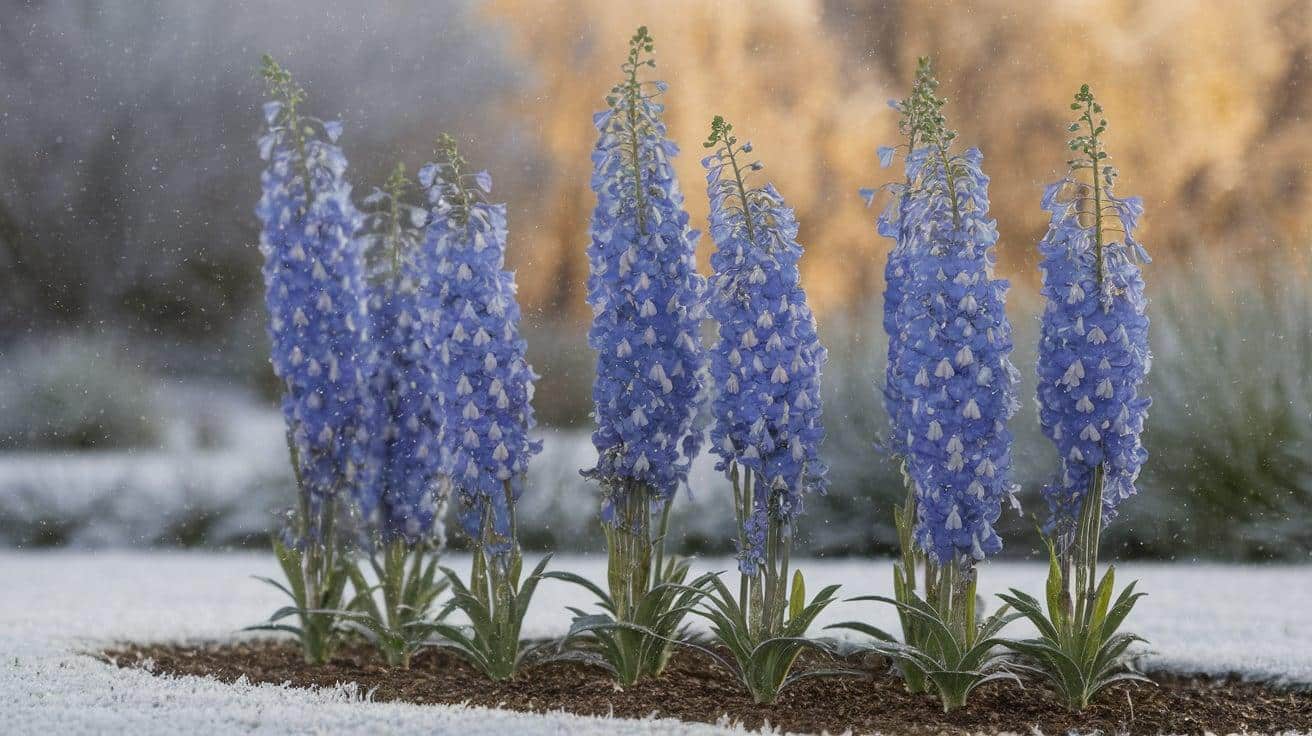
Tall spikes of blue flowers for winter gardens
Winter-blooming Delphiniums provide you with tall spikes of blue, purple, or white flowers. You’ll need to provide support for these tall perennials, but the reward is stunning vertical color in winter gardens.
Key Growing Details:
- Botanical Name: Delphinium spp.
- Sun Exposure: Full sun to partial shade
- Soil Type: Moist but well-draining
- Soil pH: 6.5 – 7.5
19. Primrose
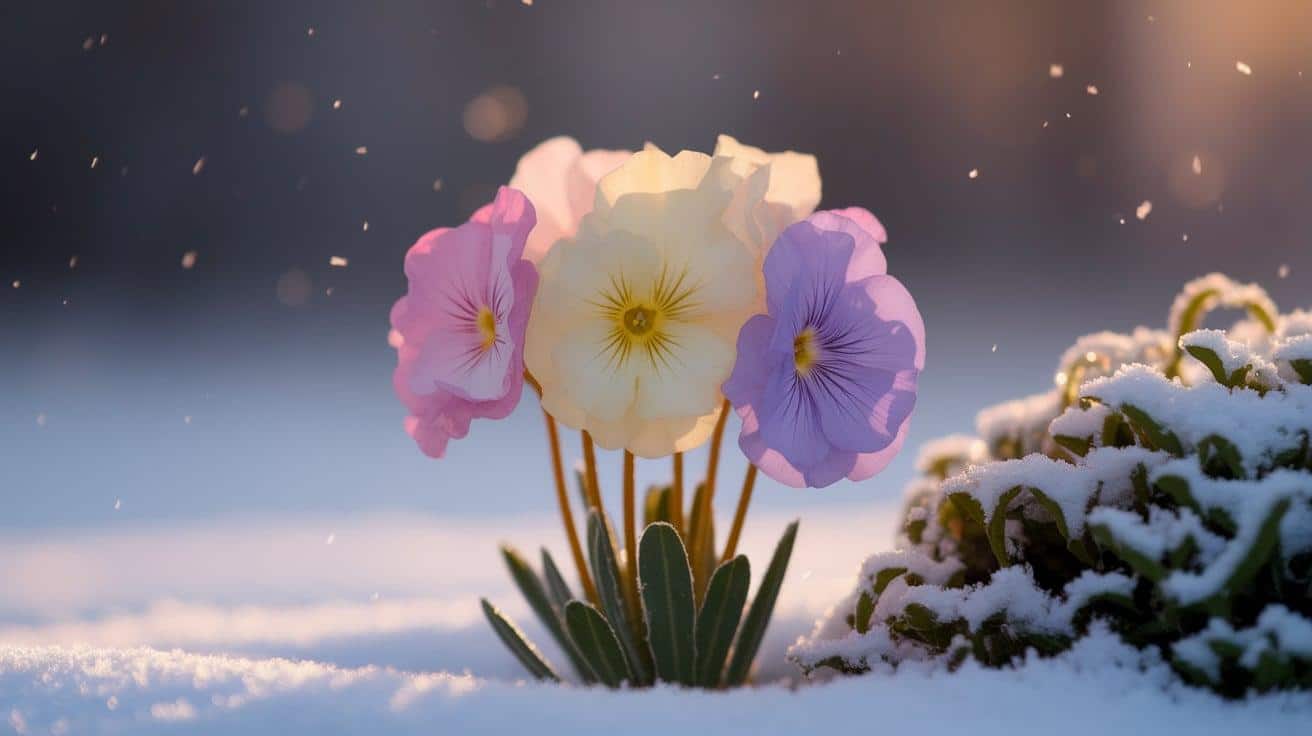
Soft pastel flowers that herald spring
Primroses offer you gentle flowers in soft yellows, pinks, purples, and whites from late winter onward. You’ll find these low-growing perennials perfect for woodland gardens, borders, or containers. They prefer cool, moist conditions.
Key Growing Details:
- Botanical Name: Primula vulgaris
- Sun Exposure: Partial shade
- Soil Type: Moist, well-draining
- Soil pH: 5.5 – 7.0
20. Holly
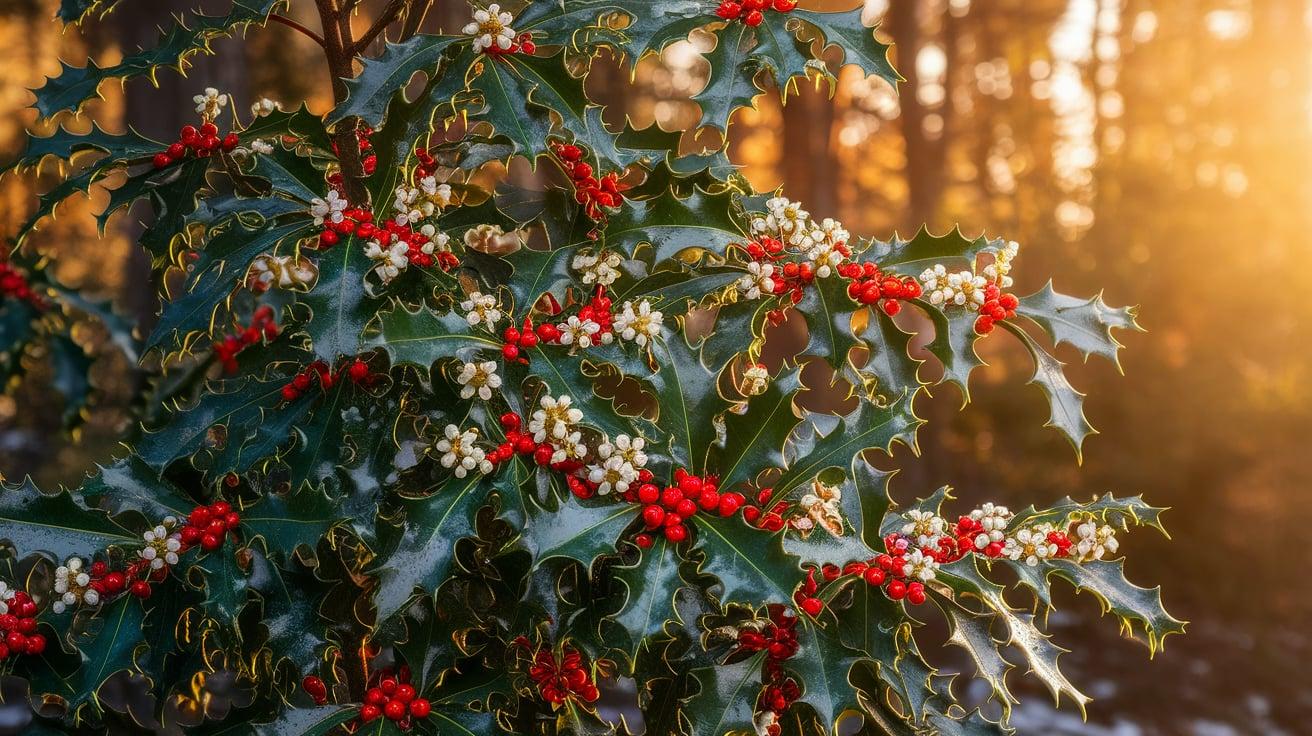
Evergreen with bright berries and small white flowers
While known for berries, Holly also produces small white flowers in late spring that develop into winter berries. You’ll need both male and female plants for berry production. The spiny evergreen leaves provide year-round structure.
Key Growing Details:
- Botanical Name: Ilex aquifolium
- Sun Exposure: Full sun to partial shade
- Soil Type: Moist, well-draining
- Soil pH: 6.0 – 7.0
21. Crocus
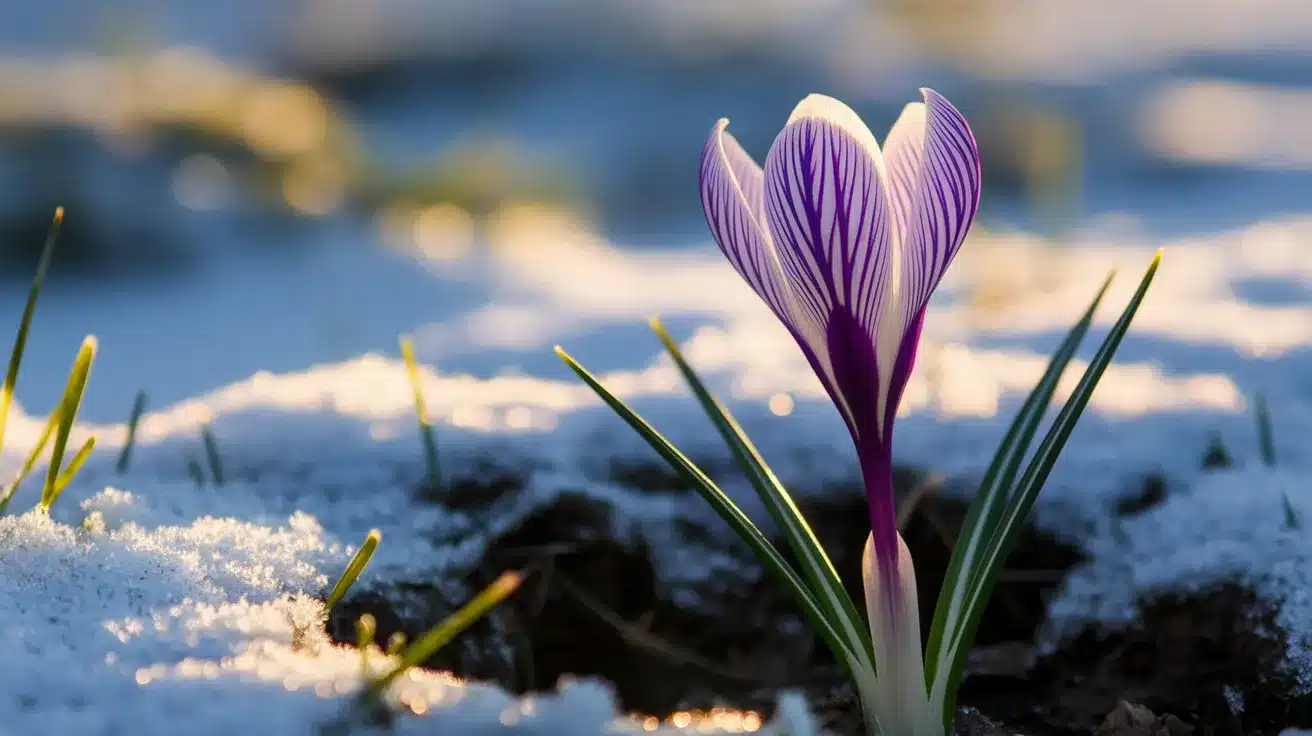
Cup-shaped flowers that open with sunshine
Crocuses give you cheerful cup-shaped flowers in purple, yellow, white, or striped varieties. You’ll love how they open wide in sunshine and close at night or in cloudy weather. These small bulbs are perfect for naturalizing in lawns or under trees.
Key Growing Details:
- Botanical Name: Crocus spp.
- Sun Exposure: Full sun to partial shade
- Soil Type: Well-draining
- Soil pH: 6.0 – 7.0
Conclusion
Winter flowers prove that your garden doesn’t need to sleep through the cold months. With these hardy varieties to choose from, you can create a landscape that blooms beautifully from December through March.
These resilient plants offer more than just color – they provide essential food for early pollinators and keep your outdoor space interesting year-round.
Start planning your winter flower garden today. Choose a mix of bulbs, such as snowdrops and Crocuses, for early color.
Combine them with fragrant shrubs like Daphne and Winter Jasmine, and add evergreen structure with Camellias and Mahonias. Remember to match each plant’s soil and sunlight needs for best results.
Your reward will be a garden that brings joy even on the coldest days. Which winter flowers will you plant first?
Frequently Asked Questions
Which Flower Is Good for Winter?
Winter roses, pansies, and camellias thrive in cold weather.
Which Flower Is Known as the Queen of Winter?
The camellia is often called the queen of winter for its elegant blooms during the coldest months.
What Flowers Are in a Winter Bouquet?
Winter bouquets typically feature evergreen branches, holly, pine cones, white roses, red berries, and seasonal flowers like amaryllis or poinsettias.
